Snow Melting Performance of Graphene Composite Conductive Concrete in Severe Cold Environment
Abstract
:1. Introduction
2. Experimental
2.1. Raw Materials
2.2. Sample Preparation
2.3. Measurement
2.3.1. Compression Measure
2.3.2. Electric-Conductivity Measure
2.3.3. Microscopic Analysis
2.3.4. Snowmelt Experiment
3. Results and Discussion
3.1. Compressive Strength
3.2. Effect of Graphene Content on Resistivity of Multiphase Conductive Concrete
3.3. Conductive Microscopic Mechanism Analysis under Different Graphene Contents
3.4. Snowmelt Test of Graphene Composite Conductive Concrete Slab
3.4.1. Effect of Different Electrode Spacings on Snowmelt Performance
3.4.2. Effect of Different Voltage on Snowmelt Performance
4. Conclusions
- When the content of graphene was 0.4% of the cement mass, the mechanical properties and electrical conductivity of the conductive concrete were significantly improved. The compressive strength first increased and then decreased with the increase of graphene content and reached a maximum strength of 45.3 MPa when the content was 0.4%. The resistivity decreased with increase in graphene content. When the content reached 0.4%, the resistivity gradually stopped decreasing and showed an upward trend; the minimum resistivity was 12.66 Ω·m.
- With increase in electrode spacing, the snow-melting efficiency and energy consumption of the graphene composite conductive concrete slab reduced. When the electrode spacing was 10 cm, snow of 21 cm thickness could be rapidly melted within 1.2 h, with a required average power density of 6.5 kW/m2 and energy consumption density of 7.8 kW·h/m2.
- The snow melting power of the graphene conductive concrete increased with increase in the electrified voltage, but the overall snow melting energy consumption first decreased and then increased with increase in the voltage. From an economic point of view, when the voltage was 156 V, the overall snow melting energy consumption was optimal.
- With 21 cm snow thickness formed in 24 h, simulating the conditions of a heavy snowstorm, the graphene composite conductive concrete slab prepared in this experiment could quickly melt the snow in 2 h with electrode spacing of 10 cm and an input voltage of 156 V, without affecting road traffic. The average power density was 3.3 kW/m2 and the energy consumption density was 6.6 kW·h/m2.
Author Contributions
Funding
Institutional Review Board Statement
Informed Consent Statement
Data Availability Statement
Conflicts of Interest
References
- He, J.; Su, Y. Research Progress on Evolution of Extreme Climate Events and Major Disaster Events. Calamities 2018, 33, 223–228. [Google Scholar]
- Sun, S.; Han, B.; Jiang, S.; Yu, X.; Wang, Y.; Li, H.; Ou, J. Nano graphite platelets-enabled piezoresistive cementitious composites for structural health monitoring-ScienceDirect. Constr. Build. Mater. 2017, 136, 314–328. [Google Scholar] [CrossRef] [Green Version]
- Gholampour, A.; Valizadeh Kiamahalleh, M.; Tran, D.N.; Ozbakkaloglu, T.; Losic, D. From graphene oxide to reduced graphene oxide: Impact on the physiochemical and mechanical properties of graphene-cement composites. ACS Appl. Mater. Interfaces. 2017, 9, 43275–43286. [Google Scholar] [CrossRef]
- Sassani, A.; Ceylan, H.; Kim, S.; Gopalakrishnan, K.; Arabzadeh, A.; Taylor, P.C. Influence of mix design variables on engineering properties of carbon fiber-modified electrically conductive concrete. Constr. Build. Mater. 2017, 152, 168–181. [Google Scholar] [CrossRef] [Green Version]
- Chen, M.; Gao, P.W.; Geng, F.; Zhang, L.; Liu, H. Mechanical and smart properties of carbon fiber and graphite conductive concrete for internal damage monitoring of structure. Constr. Build. Mater. 2017, 142, 320–327. [Google Scholar] [CrossRef]
- Liu, K. Influence Factor of Thermal Conductivity of Cement Concrete and Its Prediction Model. J. Build. Mater. 2012, 15, 771–777. [Google Scholar]
- Sassani, A.; Ceylan, H.; Kim, S.; Arabzadeh, A.; Taylor, P.C.; Gopalakrishnan, K. Development of Carbon Fiber-modified Electrically Conductive Concrete for Implementation in Des Moines International Airport. Case Stud. Constr. Mater. 2018, 8, 277–291. [Google Scholar] [CrossRef]
- Sun, Y.; Bao, H.D.; Guo, Z.X.; Yu, J. Modeling of the Electrical Percolation of Mixed Carbon Fillers in Polymer-Based Composites. Macromolecules 2009, 42, 459–463. [Google Scholar] [CrossRef]
- Wang, H.; Shi, F.T.; Shen, J.L.; Zhang, A.; Zhang, L.; Huang, H.; Liu, J.; Jin, K.; Feng, L.; Tang, Z. Research on the self-sensing and mechanical properties of aligned stainless steel fiber-reinforced reactive powder concrete. Cem. Concr. Compos. 2021, 119, 104001. [Google Scholar] [CrossRef]
- Sherif, A.Y.; Cheristopher, Y. Conductive Concrete Overlay for Bridge Deck Deicing. ACI Struct. J. 1999, 96, 382–390. [Google Scholar]
- Sherif, A.Y.; Cheristopher, Y. Conductive Concrete Overlay for Bridge Deck Deicing: Mixture Proportioning, Optimization, and Properties. ACI Mater. J. 2000, 97, 172–181. [Google Scholar]
- Berrocal, C.G.; Hornbostel, K.; Geiker, M.R.; LoFgren, I.; Lundgren, K.; Bekas, D.G. Electrical resistivity measurements in steel fiber reinforced cementitious materials. Cem. Concr. Composites. 2018, 89, 216–229. [Google Scholar] [CrossRef] [Green Version]
- Ezzatollah, S.; Felipe, B.; Yao, X.P.; Emad, B.; Abozar, A.; Duan, W.H. Graphene-based nanosheets for stronger and more durable concrete: A review. Constr. Build. Mater. 2018, 183, 642–660. [Google Scholar]
- Pan, Z.; He, L.; Qiu, L.; Korayem, A.H.; Li, G.; Zhu, J.W.; Collins, F.K.; Li, D.; Duan, W.H.; Wang, M.C. Mechanical properties and microstructure of a graphene oxide-cement composite. Cem. Concr. Compos. 2015, 58, 140–147. [Google Scholar] [CrossRef]
- Gong, K.; Pan, Z.; Korayem, A.; Qiu, L.; Li, D.; Collins, F.K.; Wang, M.C.; Duan, W.H. Reinforcing effects of graphene oxide on Portland cement paste. J. Mater. Civ. Eng. 2015, 27, A4014010. [Google Scholar] [CrossRef]
- Han, B.G.; Yu, X.; Kwon, E.; Ou, J.P. Effects of CNT concentration level and water/cement ratio on the piezoresistivity of CNT/cement composites. J. Compos. Mater. 2012, 46, 19–25. [Google Scholar] [CrossRef]
- Li, H.; Xiao, H.G.; Ou, J.P. A study on mechanical and pressure-sensitive properties of cement mortar with nanophase materials. Cem. Concr. Res. 2004, 34, 435–438. [Google Scholar] [CrossRef]
- Rehman, S.K.; Ibrahim, Z.; Jameel, M.; Memon, S.A.; Javed, M.F.; Aslam, M.; Mehmood, K.; Nazar, S. Assessment of Rheological and Piezoresistive Properties of Graphene based Cement Composites. Int. J. Concr. Struct. Mater. 2018, 12, 64. [Google Scholar] [CrossRef]
- Bai, S.; Jiang, L.H.; Jiang, Y. Research on electrical conductivity of graphene/cement composites. Adv. Cem. Res. 2018, 32, 45–52. [Google Scholar] [CrossRef]
- Wu, J.M.; Liu, J.G.; Yang, F. Three-phase composite conductive concrete for pavement deicing. Constr. Build. Mater. 2015, 75, 129–135. [Google Scholar] [CrossRef]
- Chung, D.D.L. Cement reinforced with short carbon fibers: A multi-functional material. Compos. Part B-Eng. 2000, 31, 511. [Google Scholar] [CrossRef]
- Cao, Z.; Zhao, X.H.; Xie, H.C. Resistivity-temperature behavior of carbon-fiber cement-matrix composites. J. Funct. Mater. 2003, 34, 466. [Google Scholar]
- Tuan, C.Y.; Sherif, Y. Evaluation of electrically conductive concrete containing carbon products for deicing. ACI Mater. J. 2004, 101, 287–293. [Google Scholar]
- Tuan, C.Y. Roca Spur Bridge: The Implementation of an Innovative Deicing Technology. J. Cold Reg. Eng. 2008, 22, 1–15. [Google Scholar] [CrossRef]
- Gopalakrishnan, K.; Ceylan, H.; Kim, S.; Yang, S.; Abdualla, H. Electrically Conductive Mortar Characterization for Self-Heating Airfield Concrete Pavement Mix Design. Int. J. Pavement Res. Technol. 2015, 8, 315–324. [Google Scholar]
- Ali, A.; Mohammad, A.N.; Ayoub, K.Z. Electrically conductive asphalt concrete: An alternative for automating the winter maintenance operations of transportation infrastructure. Compos. Part B 2019, 173, 106985. [Google Scholar]
- Tang, Z.Q.; Li, Z.Q.; Hou, Z.F.; Xu, D.L. Influence of Electric Heat Layer Layout of Conductive Concrete on Deicing Effect of Pavement. J. Wuhan Univ. Technol. 2002, 2, 45–48. [Google Scholar]
- Zhang, J.R.; Xu, L.N.; Zhao, Q.X. Investigation of carbon fillers modified electrically conductive concrete as grounding electrodes for transmission towers: Computational model and case study. Constr. Build. Mater. 2017, 145, 347–353. [Google Scholar] [CrossRef]
- Wen, S.; Chung, D.D.L. Electric polarization in carbon fiber-reinforced cement. Cem. Concr. Res. 2001, 31, 141–147. [Google Scholar] [CrossRef]
- Bai, S.; Jiang, L.; Xu, N.; Jin, M.; Jiang, S. Enhancement of mechanical and electrical properties of graphene/cement composite due to improved dispersion of graphene by addition of silica fume. Constr. Build. Mater. 2018, 164, 433–441. [Google Scholar] [CrossRef]
- Zhang, C.J.; Xu, W.; Cai, L.C.; Li, C.M.; Cai, H. Numerical simulation and verification of continuous carbon fiber electric heating airport pavement snow melting ice. Bull. Chin. Ceram. Soc. 2018, 37, 369–374. [Google Scholar]
- Wu, J.; Yang, F.; Liu, J. Carbon Fiber Heating Wire for Pavement Deicing. J. Test. Eval. 2015, 43, 20130344. [Google Scholar] [CrossRef]
- Won, J.P.; Kim, C.K.; Lee, S.J.; Li, J.H.; Kim, R.W. Thermal characteristics of a conductive cement-based composite for a snow-melting heated pavement system. Compos. Struct. 2014, 118, 106–111. [Google Scholar] [CrossRef]
- Malakooti, A.; Theh, W.S.; Sadati, S.M.; Ceylan, H.; Kim, S.; Phd, M.M.; Cetin, K.; Taylor, P. Design and Full-scale Implementation of the Largest Operational Electrically Conductive Concrete Heated Pavement System. Constr. Build. Mater. 2020, 255, 119229. [Google Scholar] [CrossRef]
- Li, Y.F.; Hu, S.Y.; Wu, H.Q.; Li, J.M.; Hou, L.S. Model of Heating Cable for Snow Melting and Icing on Pavement. J. Beijing Univ. Technol. 2008, 34, 1298–1303. [Google Scholar]
- Dehghanpour, H.; Yilmaz, K.; Afshari, F.; Ipek, M. Electrically conductive concrete: A laboratory-based investigation and numerical analysis approach. Constr. Build. Mater. 2020, 260, 119948. [Google Scholar] [CrossRef]
- Zhang, M.X.; Li, M.C.; Zhang, J.R.; Liu, D.H.; Hu, Y.S.; Ren, Q.B.; Tian, D. Experimental study on electro-thermal and compaction properties of electrically conductive roller-compacted concrete overwintering layer in high RCC dams. Constr. Build. Mater. 2020, 263, 120248. [Google Scholar] [CrossRef]
- GB/T 50081. Standard Test Method for Physical and Mechanical Properties of Concrete; China Building Industry Press: Beijing, China, 2019. [Google Scholar]
- GB/T 28592. Different Levels of Precipitation; Standards Press of China: Beijing, China, 2012. [Google Scholar]
- Yang, K.; Xue, J.J. The Relationship between snowfall and snow depth using intensive snowfall observations. J. Appl. Meteorol. Sci. 2013, 24, 349–355. [Google Scholar]
- Le, J.L.; Du, H.J.; Pang, S.D. Use of 2D Graphene Nanoplatelets (GNP) in cement composites for structural health evaluation. Compos. Part B Eng. 2014, 67, 555–563. [Google Scholar] [CrossRef]
- Ping, X.; Ping, G.G.; Beaudoin, J.J. Electrical percolation phenomena in cement composites containing conductive fibers. J. Mater. Sci. 1996, 31, 4093–4097. [Google Scholar]
- Cao, G.J.; Gong, J.W.; Ma, L.; Zhang, Y.; Zhang, M.L.; Zhao, Y.Q.; Liu, X.J. Influence Factors of Thermal Conductivity of Concrete under Different Temperature Conditions. J. Yangtze River Sci. Res. Inst. 2019, 36, 144–150. [Google Scholar]
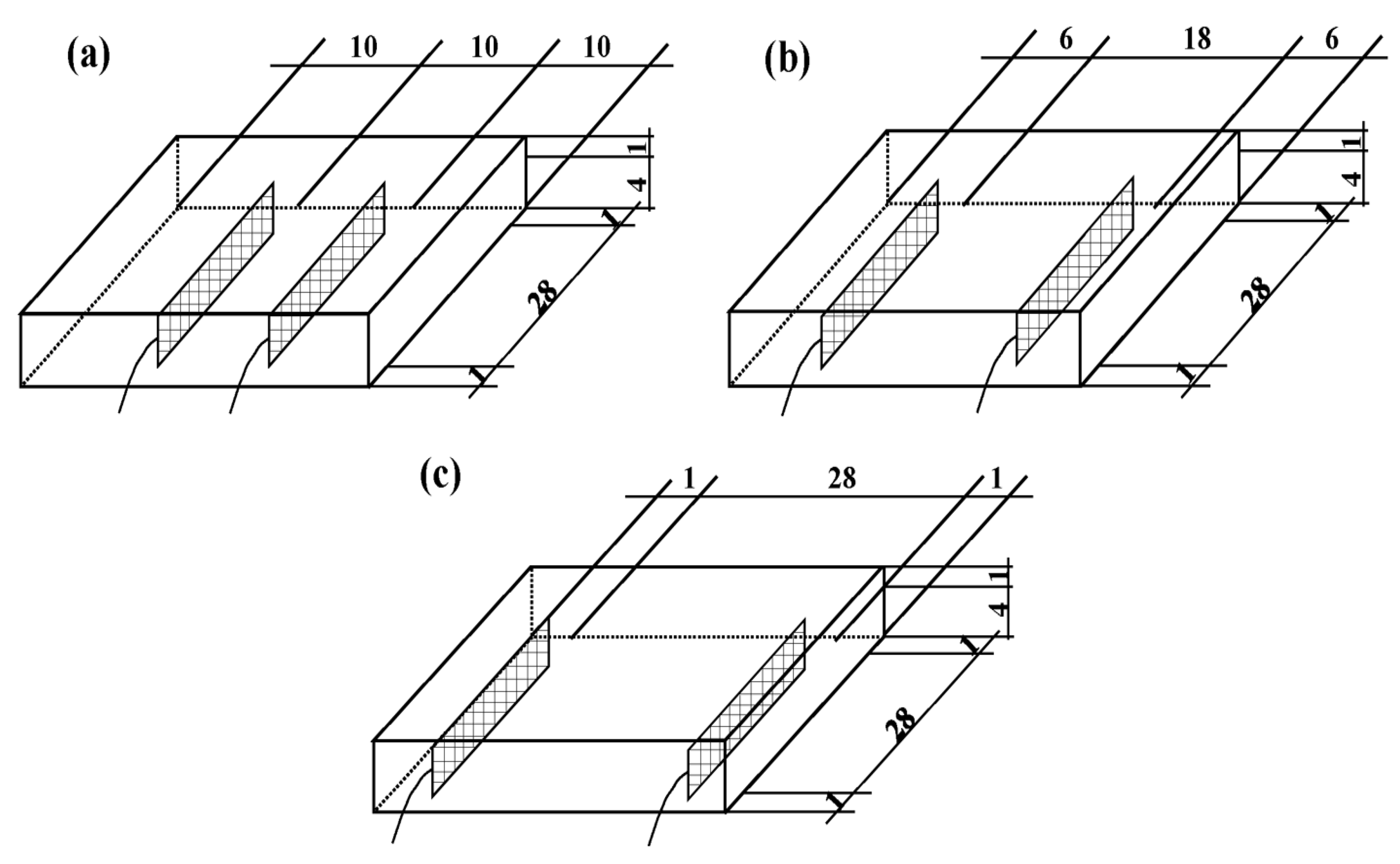


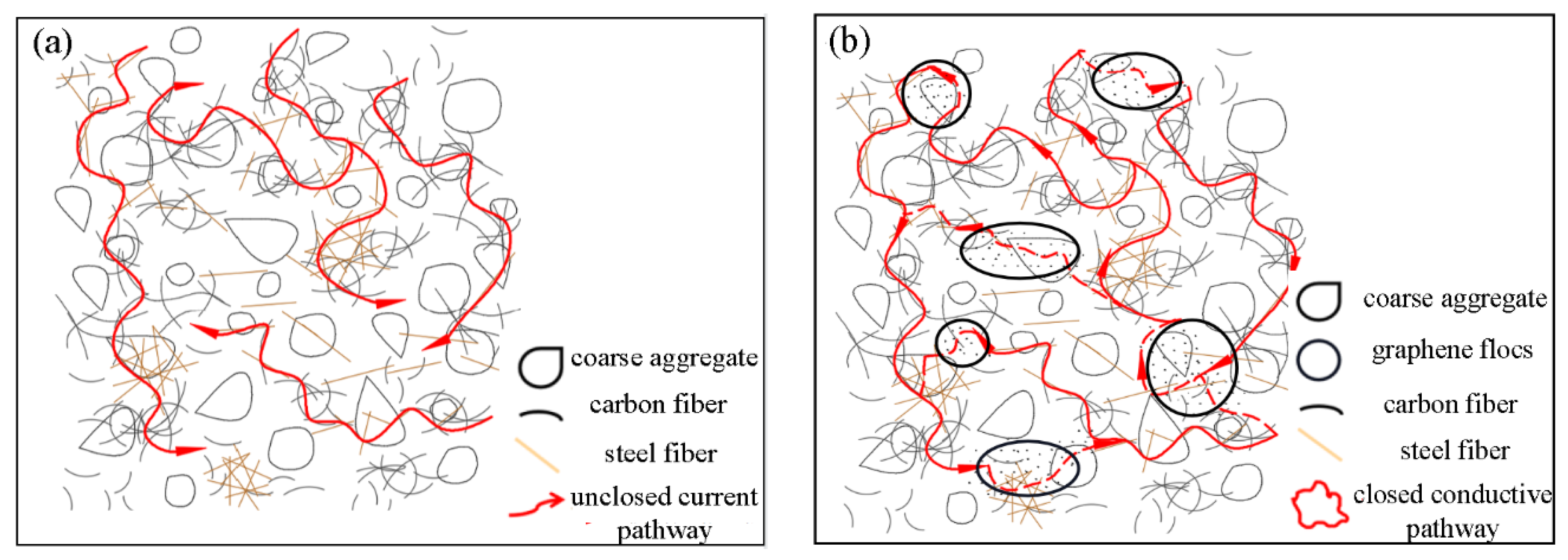
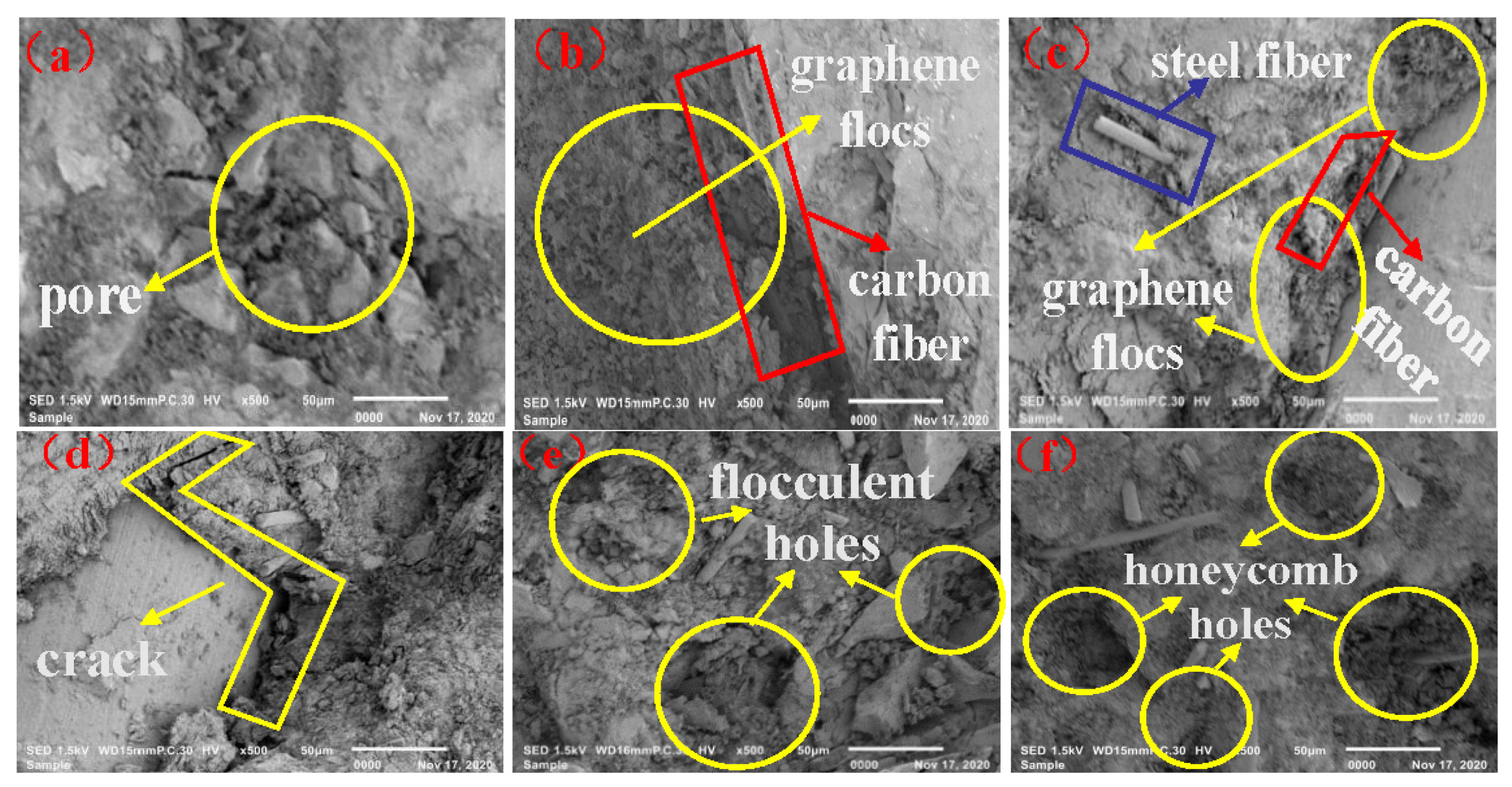

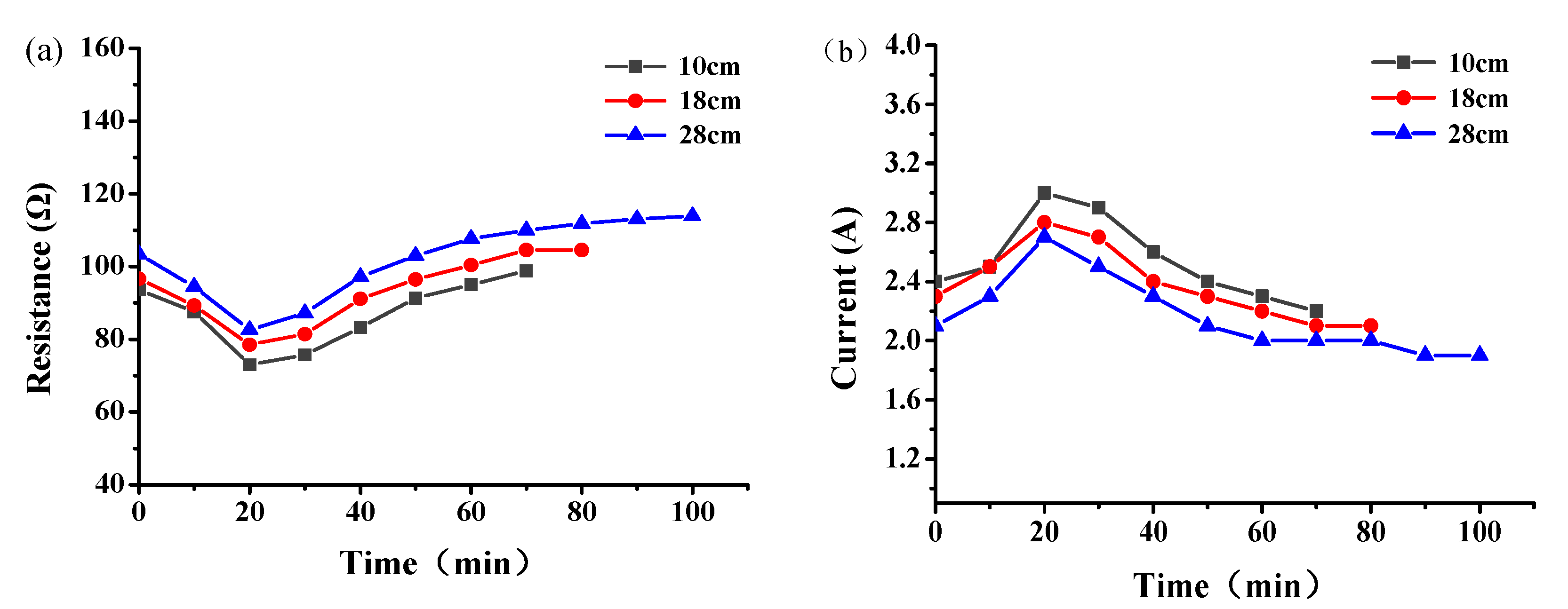
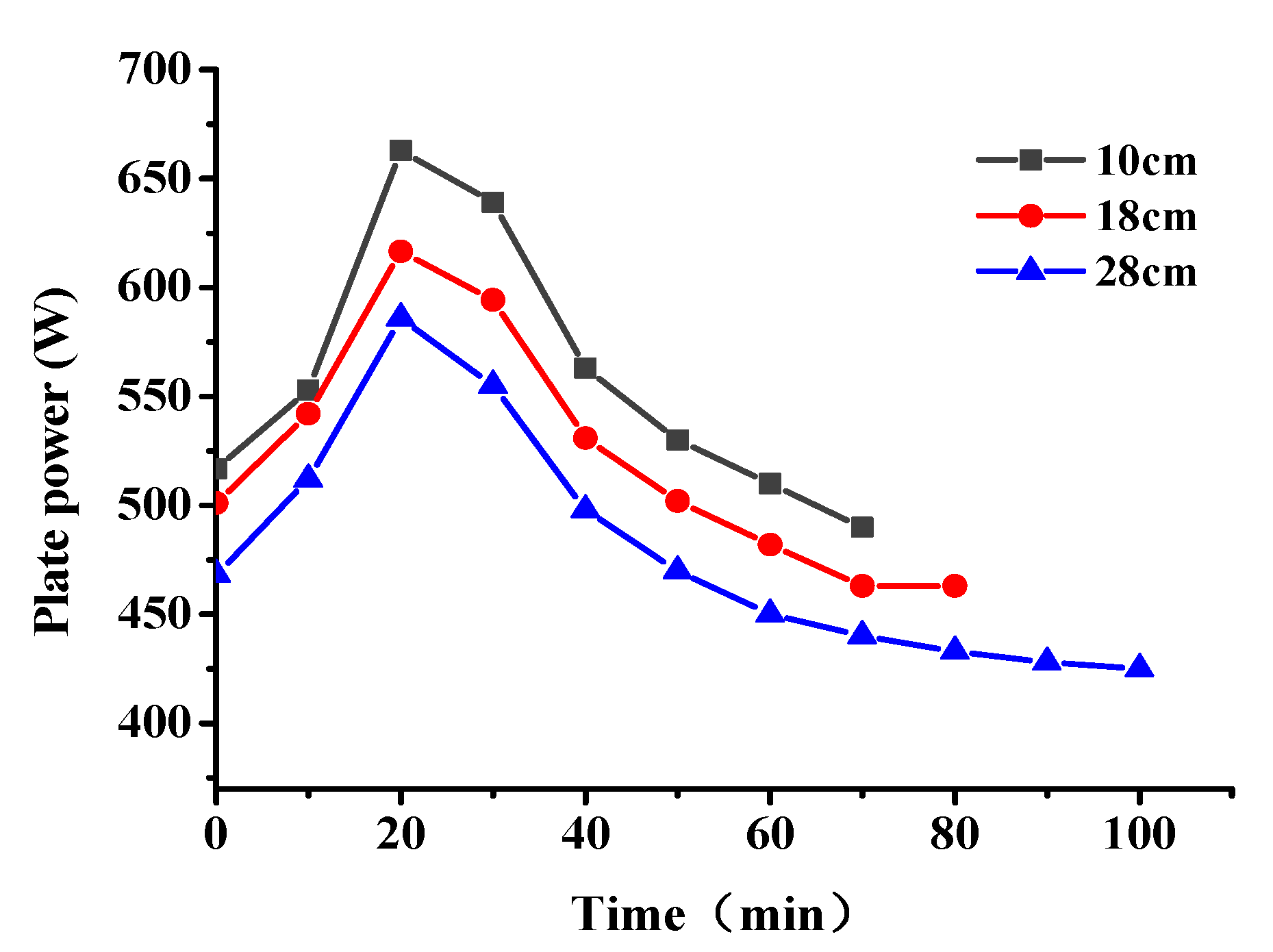

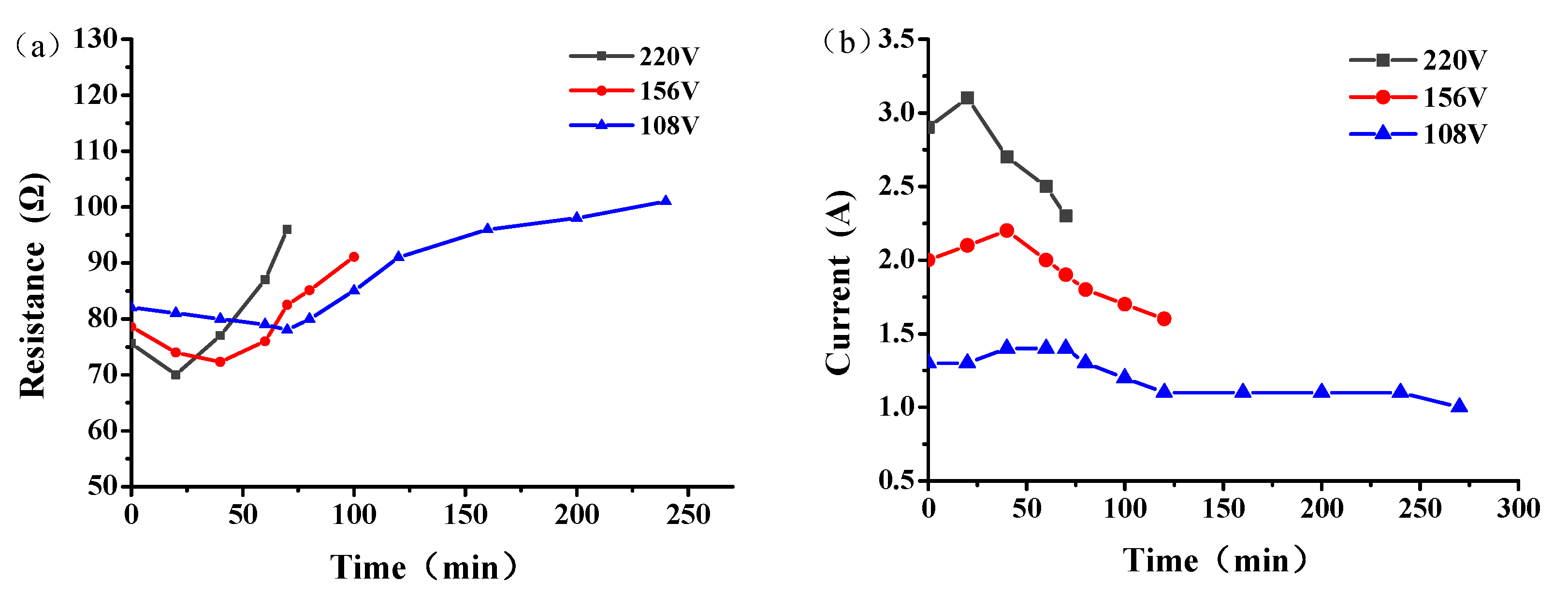
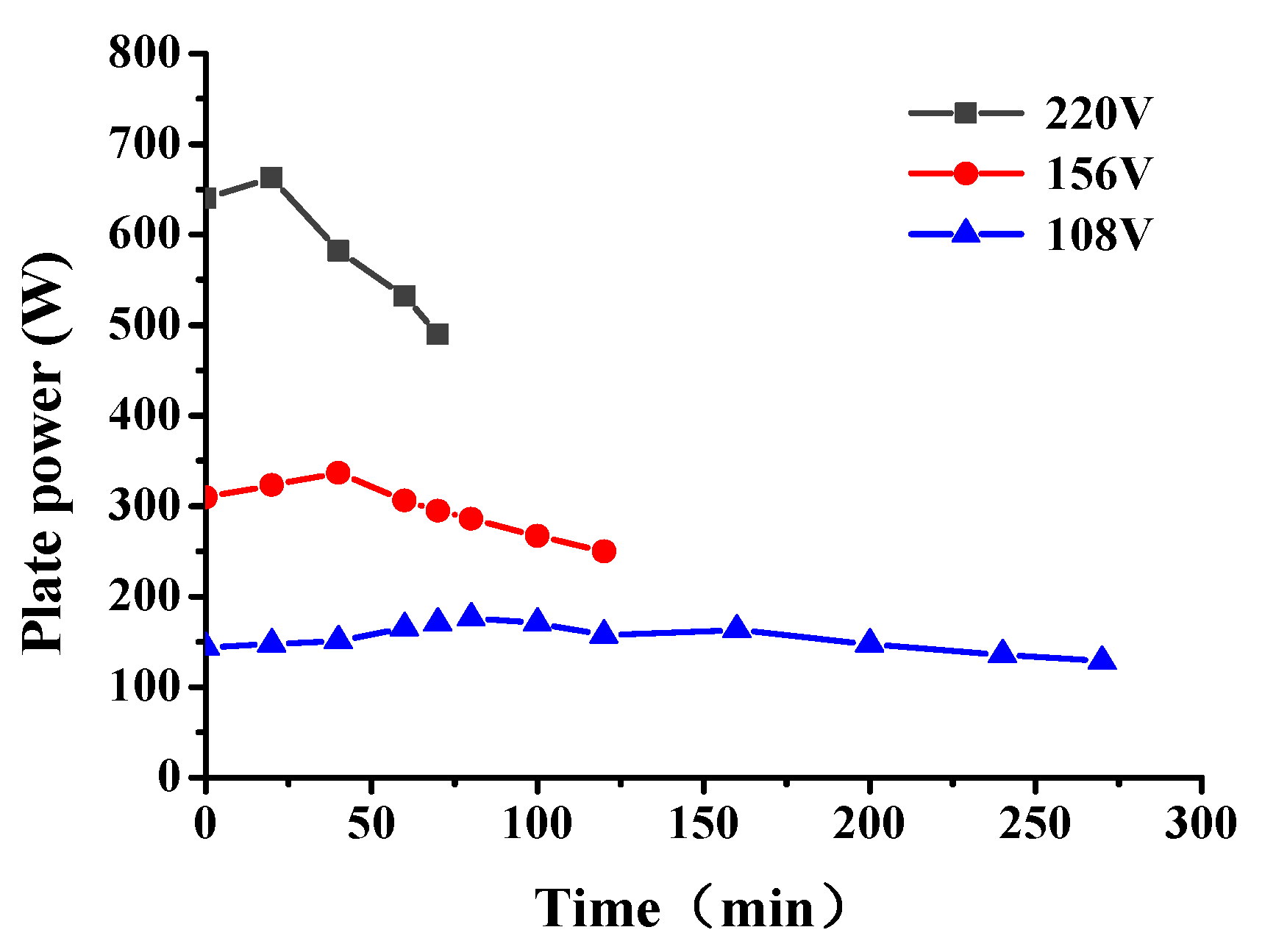
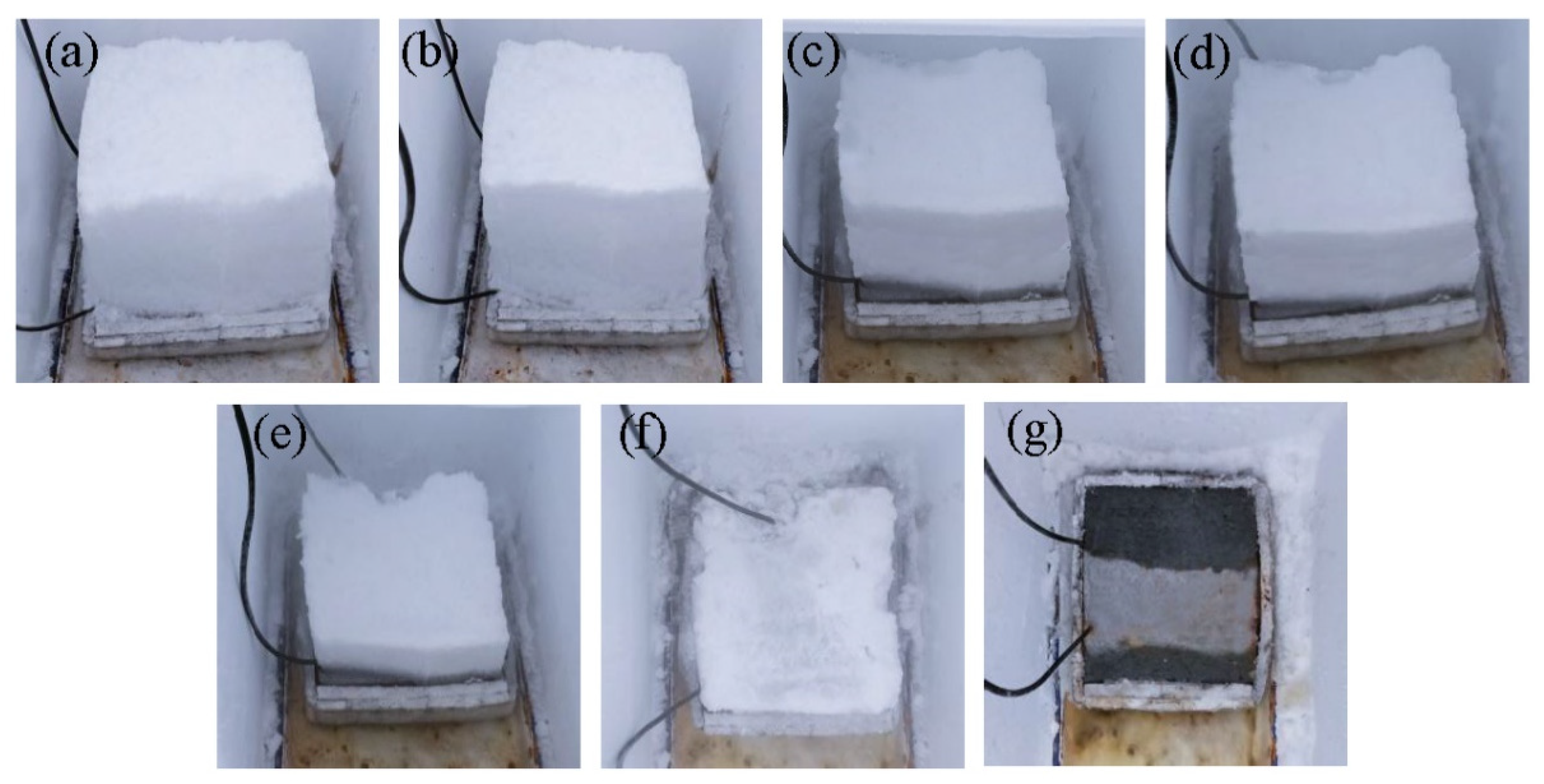
| Diameter (μm) | Thickness (nm) | Tier Number | Single Layer Rate | Purity | Specific Surface Area (m2/g) |
|---|---|---|---|---|---|
| 10–50 | 3.4–7.0 | 6–10 | 30% | >95% | 450–550 |
| Length (mm) | Monofilament Diameter (μm) | Carbon Content | Density (g/cm3) | Tensile Strength (MPa) | Tensile Modulus(GPa) | Volume Resistivity (Ω·cm) | Length to Diameter Ratio |
|---|---|---|---|---|---|---|---|
| 6 | 7.0–10 | ≥95% | 1.6–1.76 | 3.6–3.8 | 220 | 1.5 × 10−3 | 600–857 |
| Length (mm) | Monofilament Diameter (μm) | Density (g/cm3) | Tensile Strength (GPa) | Volume resistivity (Ω·cm) | Length to Diameter Ratio |
|---|---|---|---|---|---|
| 13 | 200 | 2 | 2.85 | 1.5 × 10−5 | 65 |
| Cement | Coarse Aggregate | Sand | Water | Water Reducing Admixture | Carbon Fiber | Steel Fiber | Graphene | Dispersing Agent |
|---|---|---|---|---|---|---|---|---|
| 450 | 975 | 766 | 198 | 2.7 | 1.8 | 20 | 0 | 0 |
| 0.9 | 1.8 | |||||||
| 1.8 | 3.6 | |||||||
| 2.7 | 5.4 | |||||||
| 3.6 | 7.2 | |||||||
| 4.5 | 9.0 |
| Graphene content/wt.% | 0 | 0.2 | 0.4 | 0.6 | 0.8 | 1.0 |
| Compressive strength/MPa | 42.5 | 44.1 | 45.3 | 40.7 | 39.1 | 37.6 |
Publisher’s Note: MDPI stays neutral with regard to jurisdictional claims in published maps and institutional affiliations. |
© 2021 by the authors. Licensee MDPI, Basel, Switzerland. This article is an open access article distributed under the terms and conditions of the Creative Commons Attribution (CC BY) license (https://creativecommons.org/licenses/by/4.0/).
Share and Cite
Wang, X.; Wu, Y.; Zhu, P.; Ning, T. Snow Melting Performance of Graphene Composite Conductive Concrete in Severe Cold Environment. Materials 2021, 14, 6715. https://doi.org/10.3390/ma14216715
Wang X, Wu Y, Zhu P, Ning T. Snow Melting Performance of Graphene Composite Conductive Concrete in Severe Cold Environment. Materials. 2021; 14(21):6715. https://doi.org/10.3390/ma14216715
Chicago/Turabian StyleWang, Xinjie, Yongkang Wu, Pinghua Zhu, and Tao Ning. 2021. "Snow Melting Performance of Graphene Composite Conductive Concrete in Severe Cold Environment" Materials 14, no. 21: 6715. https://doi.org/10.3390/ma14216715
APA StyleWang, X., Wu, Y., Zhu, P., & Ning, T. (2021). Snow Melting Performance of Graphene Composite Conductive Concrete in Severe Cold Environment. Materials, 14(21), 6715. https://doi.org/10.3390/ma14216715






